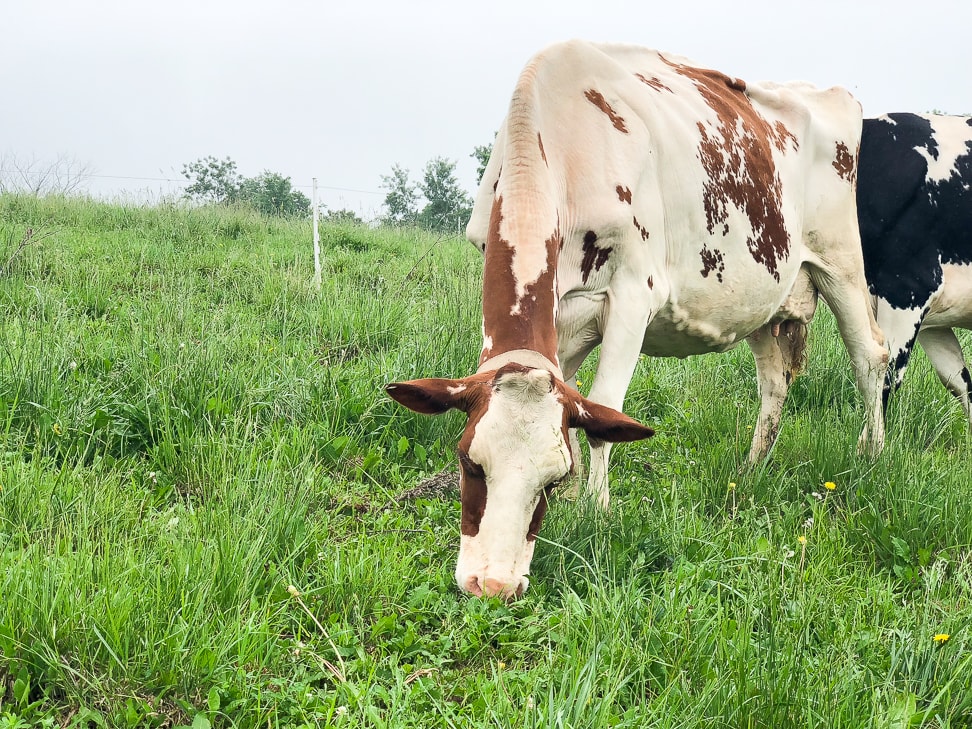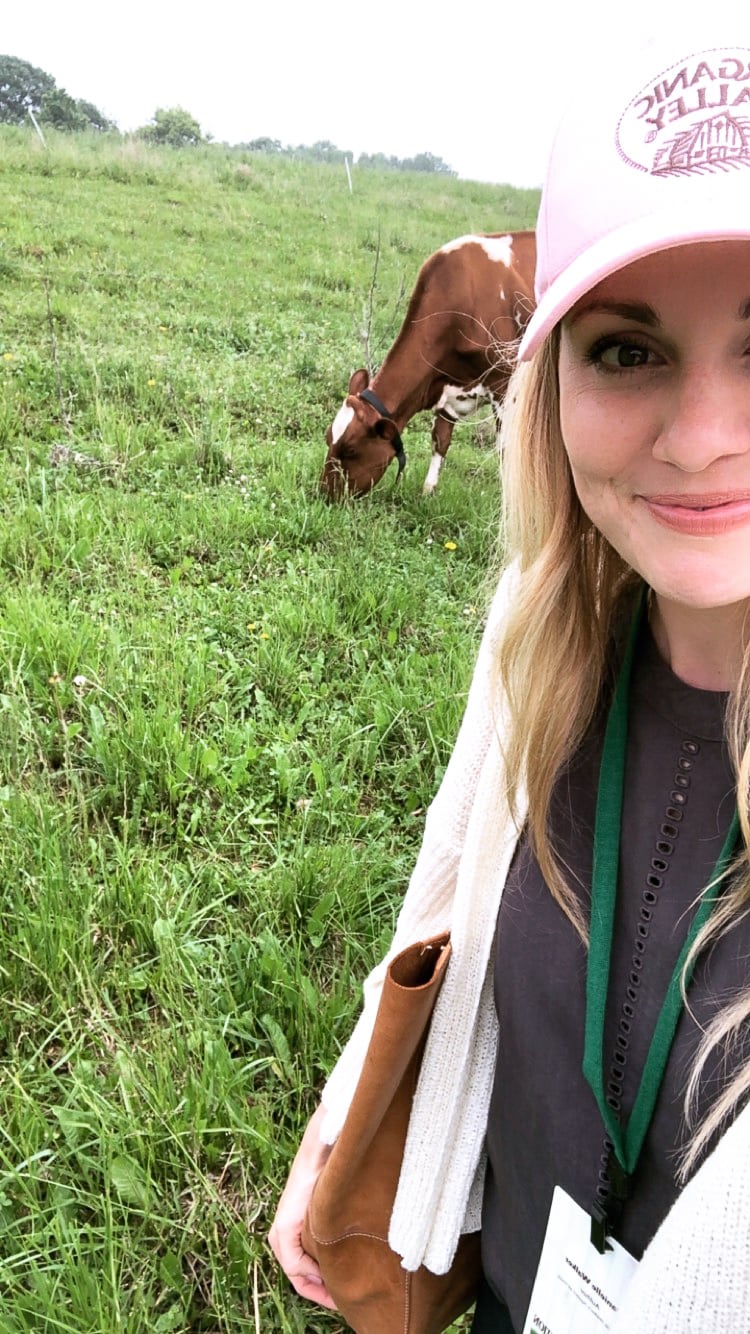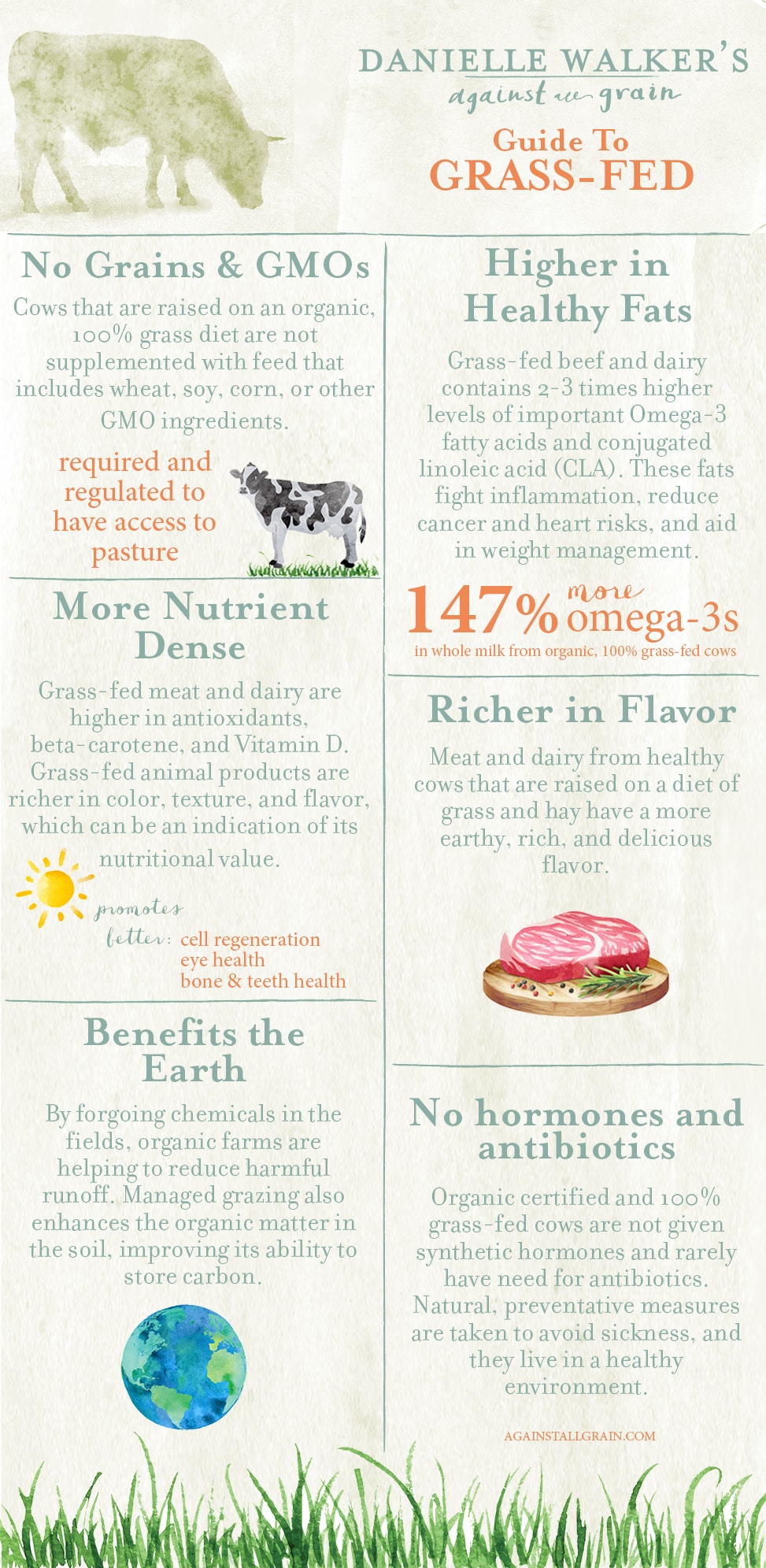
Last month, I had the opportunity to partner with Organic Valley in Wisconsin. They invited us into their offices, and onto one of their organic grass-fed dairy farms and engaged us in great conversation surrounding the farming industry. We got to interact with a variety of different employees, as well as real farmers who are part of the co-op. I was excited for the trip (let’s be honest – I was excited to see horses, baby goats, and sweet baby cows), but really did not anticipate learning as much as I did!
My body doesn't tolerate milk or cream, but after removing dairy completely from my diet for a few years and allowing my gut to heal, I found that I could tolerate select dairy. I slowly added certain ingredients back into my diet like grass-fed hard cheese, ghee which is 99% free of lactose and casein, and some fermented dairy like kefir and unsweetened yogurt. My kids also consume grass-fed dairy, so I was particularly interested to learn more about the Organic Valley Grassmilk product line that we have been buying since 2011.
We started buying grass-fed dairy when I transitioned Asher from breast milk to milk in 2011. I originally began purchasing only grass-fed dairy because of our grain-free lifestyle and because I didn’t want my kids being exposed to synthetic hormones. I figured that dairy from cows that were not fed any grain in their feed would be easier for me to digest, given my digestive intolerance to grains.
Little did I know, at the time, that grass-fed dairy and beef actually has immense health benefits over it's conventional (and even organic!) counterparts. I was unaware of the benefits that managed grazing has for our environment, or how much work it takes for a farm to run this way. Below are some of the things I learned that I want to share with you all!

What Grass-Fed Means
I am asked frequently what all the different terms mean when it comes to packaging and labels for dairy and beef.
The term grass-fed has many different meanings, and it varies between the type of product you’re purchasing. When you see the terms “pastured” or “grass-fed” on a label, they are generally unregulated and could mean that the animal’s diet included grains.
When your meat labels claim“ grass-fed” it indicates that the cows are raised on a 100% grass-fed diet, never any grains. USDA’s FSIS regulates labeling of meat and egg products and have guidance for “grass-fed” or “100% grass-fed” claims on meat. There is a preapproval process for a label claim but unfortunately it is not rigorous, and is not enforced regularly. Conventional beef cattle can claim pasture-raised but still be “finished” or supplemented with grain feed. This is why I always suggest asking your butcher or farmer if the beef comes from cows that are grass-fed AND finished. 100% grass-fed cows are required to have daily access to the outdoors, sunlight and fresh air, except during extreme weather conditions. Similarly to grass-fed dairy cows, they are fed stored hay during the winter.
For conventional dairy products, companies can use marketing ploys like photos of cows grazing on grass and even say grass-fed on their labels, but there’s no regulation for how frequently they graze or how much grain feed they’re given. If the dairy products are organic, which I recommend, the cows are required under the USDA organic certification to have a minimum grazing season of 120 days, depending on the location and climate. Organic dairy cows are required to have 30% of their Dry Matter Intake (DMI) be a diet from grazing during the grazing season, and the remainder can be from grain feed. Even organic dairy cows can be fed organic soy, wheat, and corn, so if you are particularly sensitive to those foods, as I am, I highly suggest seeking out 100% grass-fed and finished dairy.
If you cannot afford 100% grass-fed dairy or have a hard time locating it, I was pleasantly surprised to learn that Organic Valley’s co-op average of grazing season is a full two months longer than required by US organic requirements, and during that time, OV farms are also providing the cows with more than 20% more intake from pasture than required by organic certifiers. Of course, their Grassmilk products are made from cows who eat grass 100% of the time.
The Reality of Managed Grazing
You would think that allowing your cows to roam freely and feed off the natural land would be easier for the farmers, but it actually takes a lot more work and requires a lot of attention. The OV co-op of grass-fed farms have smaller herd sizes, so the farmers are able to give the animals the attention they need, rather than thousands of cows from a standard factory production. In order for the herd to get the nutrients they need, the farmer has to move them to different pastures throughout the day, allowing the previously grazed pasture to regrow before leading them back there. This is referred to as managed grazing.
I also thought it was fascinating how much thought has to go into what is actually grown in the pastures. The farmers have to select grasses to plan that will nourish the cows best, and are constantly planting new plants in addition to the grass that naturally grows in the fields. We learned that a cow needs some sugar to balance the forage protein and aid in fermentation- and if grasses have high sugar levels, the cows don’t need any grain to fill them up.
Because of weather during the winter, they also have to store hay from the fields to feed the animals when conditions do no permit outdoor grazing. Unfortunately, there are GMO hay and alfalfa on the market, so another reason to always want seek out 100% grass-fed AND organic dairy and beef is to ensure your food is free of GMO.

Grazing and the Welfare of the Animals
There are so many reasons behind why consuming grass-fed dairy and meat is better not only for the cows themselves, but for our health and the health of our environment.
Conventional farms typically rely on corn and soy products to feed their cows because it is cheap to grow and harvest, but there are side affects for the cows and those foods make their way into the meat and milk you ingest.
I learned from the organic veterinarian who spoke at our gathering that cows are not designed to operate on soy and corn; it is not easy for them to digest. The grains they are typically fed contain too much starch for them to digest, which negatively affects their microbiome. We talk a lot about our own microbiomes, but I never really thought of it from the animal’s perspective too!
These grains are likely de-mineralized, which negatively affects the PH of the animal. Not only do cows get to graze on grass and hay when they live their life on pasture, but they also benefit from being outdoors with the sun giving them vitamin D. Unfortunately, a lot of cows living in a conventional dairy production farm barely see pasture.
I believe in treating the animals that sustain us with the utmost respect. We have all seen some of the documentaries over the years exposing some of the poor practices in mass-production farms, and it’s enough to make someone consider go vegetarian for the sake of the animals and in protest of these types of establishments.
In reality- I could not survive without animal protein. My autoimmune disease does not allow me to eat legumes and grains, and it thrives when I consume grass-fed and organic protein. So it’s important to me that the I’m supporting the farms who are doing it the right way, hoping to make a difference by spending my money and increasing the demand for organic and grass-fed products from farms that allow their animals the best quality of life and treat them well.
I was unaware of the high standards that Organic Valley has for their farms in regards to animal care and treatment, but was really quite impressed with how important it is to them. They believe that cows that live the life they were intended to live – freely grazing on grass with enough space to move around in the sunlight – live a lower-stress live. The happier the animals are, the healthier the milk, eggs, and meat they produce. This was really reflected by the farmers we met, and it was very apparent that they loved their animals and devoted their lives to providing them with the upmost care. After all, their businesses thrive when their animals are happy and healthy. Not only do they produce higher quality foods, but also the farmer’s overhead costs are lower.
GMO and pesticide-laden feed, antibiotics, and synthetic hormones can cause an array of health issues in animals – leading to stress and medications. Veterinarian visits and these medications can also be costly for a farmer when needed frequently. These toxins also make their way into the milk or meat we as humans consume, which can contribute to inflammation, digestive issues, and chronic illness. So it’s really in the best interest of the farmer, the animals, and the consumer to use natural preventative measures to keep the animals healthy.

Grass-fed and Nutrient Density
From a nutritional standpoint – studies show that grass-fed cows produce more nutrient-dense foods. They contain higher levels of important Omega-3 fatty acids and CLA, are high in antioxidants and are higher in beta-carotene, Vitamin D, and Vitamin E. Grass-fed animal products are richer in color, texture and flavor, which is an indication of its nutritional value. Grass-fed butter actually spreads more easily because the unsaturated fats are softer!
A new study released by Organic Valley found that their Grassmilk tested 147% higher in Omega-3 and 125% higher in CLA than conventional milk. Their Grassmilk tested 62% higher in Omega-3 than even their own standard organic milk! Many people give their children milk because they think the calcium is good for them, but I love that they’re getting these anti-inflammatory Omega-3s!
You have probably heard a lot about beneficial Omega-3 fatty acids but may not understand the importance of them, or that Americans typically have an imbalance of 3 vs 6.
In a nutshell, there are two types of fatty acids essential for human health: Omega-6 and Omega-3. Omega-3s are “good fats” that play a vital role in every cell and system in the human body. Scientists believe omega-6s are pro-inflammatory, while omega-3s are anti-inflammatory.
Unfortunately; the American diet is deficient in Omega-3s and overloaded with Omega-6s from consuming oils such as sunflower, canola, corn, soybean and cottons. Conventionally raised meats like chicken and pork may also be high in omega-6. This imbalance leads to inflammation and increases the risk of obesity, cancer, cardiovascular disease, depression and autoimmune disorders.
Most people think that the only way to increase their Omega-3 levels is to consume more fatty fish like salmon (which is definitely a great choice!), but you can also get it from grass-fed dairy products and meat.
If you need to supplement – cod liver oil is a good choice that contains added vitamins D and A. While there are some plant sources such as flax and chia seeds that are touted as being high in omega-3, they contain a type of omega-3 called ALA. The human body is has difficulty converting ALA into the active forms that benefit us.
For this reason, animal sources of omega-3s, such as fish and grass-fed animals, are usually better choices.
To locate grass-fed animal protein in your area, see EatWild.com or look for the following products in your super market:

- Organic Valley Grassmilk Plain Yogurt
- Organic Valley Grassmilk Organic Milk
- Organic Valley Grassmilk Raw Cheddar Cheese
- Organic Valley Pasture-raised Ghee
Here are some other great articles if you’re interested in reading more about the nutritional benefits of grass-fed dairy and meat
- Organic Valley’s study on grassmilk nutrition
- Omega-3 and CLA in grass-fed products
- Vitamins and antioxidants in grass-fed products
- How managed grazing produces more nutrient-dense foods
- https://www.ncbi.nlm.nih.gov/pmc/articles/PMC2846864/
Organic, Grass-fed and the Environment
In addition to organic just generally being better for our health and the health of the animals, it is also significantly better for the environment. By forgoing chemicals in the fields, organic farms are helping to reduce harmful runoff. I was surprised to learn that grass-fed farmers keep their herd in smaller pastures because when they are crowded, they tend to eat with more vigor and the grass becomes more nutritious from the hooves working the soil.
Managed grazing enhances the organic matter in the soil, improving its ability to store carbon. Organic farming creates more biodiversity and wildlife habitat by increasing a healthy habitat for diverse species like beneficial insects, reptiles, amphibians, birds and mammals. It protects the soil and water and reduces the use of fossil fuels and synthetic inputs.
If you’re interested in reading more about the environmental benefits of grass-fed farms, I found this article very interesting.

I partnered with Organic Valley for this post. I was compensated for my time in researching and compiling my findings. My opinions are always my own and I only partner with brands I personally use, trust, and want to share with you.

AJ Burton
” organic requires that a cow get 30% of her DMI from grass, rest can be from grains ” – FYI folks, no dairy cow is getting fed 70% of her diet in grain ! Now, I’m not endorsing much or even any grain consumption, by cows. I am just wanting non-farm folks to know – any misinfo loses u credibility w conventionals . Besides grass – if on it at all- they get hay &/or haylage – most always not pure alfalfa, btw, incls “weeds” & grass -, corn silage ( made from th whole plant ). Then corn & soybean meal, in a fraction of the whole. Though most (conv.)dairies today really max the corn. Only grain-finished steers are fed totally corn,& at the end.
Robyn Cafiero
I do not see on the labels that the products are grass finished as well. Many companies will proudly put that on their labels.
John Henry
Grass fed beef is the healthiest beef to eat,